|
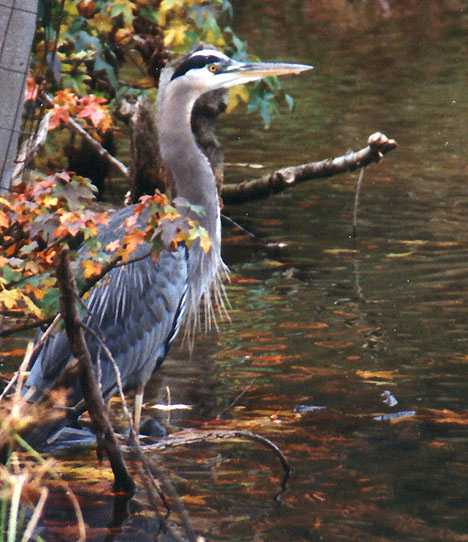 The
stately great blue heron is the largest, most widely distributed of American
herons. Whether flying majestically overhead or standing motionless at
the water's edge on a still, misty morning awaiting an unsuspecting fish,
the great blue heron embodies grace and elegance. The
stately great blue heron is the largest, most widely distributed of American
herons. Whether flying majestically overhead or standing motionless at
the water's edge on a still, misty morning awaiting an unsuspecting fish,
the great blue heron embodies grace and elegance.
The
great blue heron is easily distinguished from other members of the heron
family. It is a four-foot tall wading bird with a dark gray body, brown
neck, chestnut thighs, and white crown, cheeks, and throat. Two distinguishing
long, black occipital crests arise from the crown stripe in adults. As
is typical of herons, great blues have a short, blunt tail, extremely
long legs and neck, and a sharp bill. In flight, the legs trail behind
the body, and motion is maintained by slow, powerful strokes of wings
that can span six feet.
Life History
Great blue herons breed across the United States and southern Canada,
and more than half of the Atlantic coast's breeding population nest
in Chesapeake Bay--predominantly in wetlands. Although many herons migrate
through the Bay region, some great blues remain in the Bay area year-round.
These waterbirds use a variety of different feeding methods to procure
their primary diet of small fish, which they swallow head first. They
also eat frogs, salamanders, lizards, snakes, crawfish, small birds,
rodents and insects.
Nesting
Herons form pair-bonds, usually in March and April, after a series of
courtship rituals performed by both sexes. The occipital crests are raised
in display during courtship and both sexes change body coloration, although
the male becomes more brightly adorned.
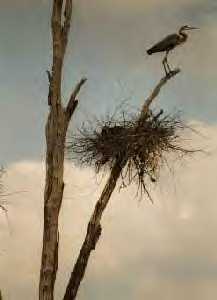 Although
great blue herons occasionally nest singly, most breed in localized colonies
of up to hundreds of nesting pairs. Heron colonies are often termed rookeries
after a European member of the crow family, the colonial rook, that also
nests in colonies. Nesting sites are primarily living, but occasionally
dead, trees and bushes. The location of the colony depends upon an available
food supply for raising the young in close proximity to nesting trees;
however, the birds show a preference for stands of loblolly pine, beach,
oak and large, old sycamore trees. Initially, the inner section of a stand
of trees is utilized, but continual colony use may eventually kill that
area. When the center of the tree stand dies, the colony moves circularly
outward in succeeding years. This strategy creates a "donut"
or "bullseye" effect when the tree stand is aerially viewed.
Nests are constructed of sticks and, if not collapsed by winter weather,
may be repaired and used year after year. The nest is lined with reeds,
mosses and grasses to help cushion three to seven eggs that are laid during
March and April. Eggs hatch after about 28 days, and both parents care
for the chicks. The young are initially fed a diet of regurgitated food,
but eventually eat whole fish dropped into the nest. Juveniles leave the
nest after about 60 days and, if they survive their first winter, may
live for another fifteen years. Although
great blue herons occasionally nest singly, most breed in localized colonies
of up to hundreds of nesting pairs. Heron colonies are often termed rookeries
after a European member of the crow family, the colonial rook, that also
nests in colonies. Nesting sites are primarily living, but occasionally
dead, trees and bushes. The location of the colony depends upon an available
food supply for raising the young in close proximity to nesting trees;
however, the birds show a preference for stands of loblolly pine, beach,
oak and large, old sycamore trees. Initially, the inner section of a stand
of trees is utilized, but continual colony use may eventually kill that
area. When the center of the tree stand dies, the colony moves circularly
outward in succeeding years. This strategy creates a "donut"
or "bullseye" effect when the tree stand is aerially viewed.
Nests are constructed of sticks and, if not collapsed by winter weather,
may be repaired and used year after year. The nest is lined with reeds,
mosses and grasses to help cushion three to seven eggs that are laid during
March and April. Eggs hatch after about 28 days, and both parents care
for the chicks. The young are initially fed a diet of regurgitated food,
but eventually eat whole fish dropped into the nest. Juveniles leave the
nest after about 60 days and, if they survive their first winter, may
live for another fifteen years.
Future
 In
the past, herons and egrets were shot for their feathers, which were used
as cooking utensils and to adorn hats and garments, and they also provided
large, accessible targets. The slaughter of these birds went relatively
unchecked until 1900 when the federal government passed the Lacey Act,
which prohibits the foreign and interstate commercial trade of feathers.
Greater protection was afforded in 1918 with the Migratory Bird Treaty
Act, which empowered the federal government to set seasons and bag limits
on the hunting of waterfowl and waterbirds. With this protection, herons
and other birds have made dramatic comebacks. In
the past, herons and egrets were shot for their feathers, which were used
as cooking utensils and to adorn hats and garments, and they also provided
large, accessible targets. The slaughter of these birds went relatively
unchecked until 1900 when the federal government passed the Lacey Act,
which prohibits the foreign and interstate commercial trade of feathers.
Greater protection was afforded in 1918 with the Migratory Bird Treaty
Act, which empowered the federal government to set seasons and bag limits
on the hunting of waterfowl and waterbirds. With this protection, herons
and other birds have made dramatic comebacks.
In
recent years, great blue herons have had to face new challenges. Loss
of nesting sites, and deterioration of water quality and wetland habitat
are issues of concern for heron survival. Natural generation of new nesting
islands, created when old islands and headlands erode, has decreased due
to artificial hardening of shorelines with bulkheads. Poor water quality
reduces the amount of large fish and invertebrate species available in
wetland areas. If suitable feeding and nesting areas are not maintained,
populations of great blue herons will eventually decline. Toxic chemicals
that enter the Bay from runoff and industrial discharges pose yet another
threat. Although great blue herons currently appear to tolerate low levels
of pollutants, these chemicals can move through the food chain, accumulate
in the tissues of prey and may eventually cause reproductive failure in
the herons.
Care
must be taken to preserve nesting sites, as well as feeding areas. Erosion
of island nesting areas due to artificial structural development, as well
as sea level rise, needs to be carefully monitored. Nesting sites should
be observed from a distance of at least 200 meters to minimize disruption
of the colony. If herons are disturbed frequently, they may abandon their
nests or neglect their young. Deterioration of submerged aquatic vegetation
limits foraging area potential. Wetland foraging sites within 15-20 kilometers
of heron colonies need special protection to ensure prey availability.
|

 Big
Blue Heron was standing in the marsh looking at his reflection in
the water. He raised his black-crested head to listen.
Big
Blue Heron was standing in the marsh looking at his reflection in
the water. He raised his black-crested head to listen.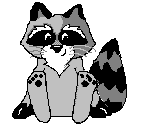 "Yes,
Mother, he is tall as a tree. Were I so tall, I could carry you
across this swift river."
"Yes,
Mother, he is tall as a tree. Were I so tall, I could carry you
across this swift river."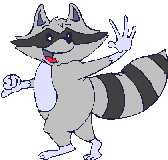 They
all went to the old tree lying in the water. Blue Heron lay down
in the water at the end and stuck his bill deep into the bank on
the other side. Mother and son Raccoon ran lightly and quickly across
the log, over Blue Heron, and were safe and dry on the other side.
They thanked Blue Heron and said they would tell all the persons
in the woods how fine Blue Heron was. Then they went on their way.
They
all went to the old tree lying in the water. Blue Heron lay down
in the water at the end and stuck his bill deep into the bank on
the other side. Mother and son Raccoon ran lightly and quickly across
the log, over Blue Heron, and were safe and dry on the other side.
They thanked Blue Heron and said they would tell all the persons
in the woods how fine Blue Heron was. Then they went on their way.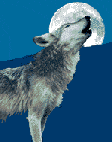 Blue
Heron was angry. He didn't like being called a bridge. Old Wolf
saw he had spoken foolish words and decided to use honeyed words.
Blue
Heron was angry. He didn't like being called a bridge. Old Wolf
saw he had spoken foolish words and decided to use honeyed words.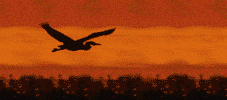 "You
wait here, Wolf, for another heron to come and carry you to the
other side." Then he flew into the marsh.
"You
wait here, Wolf, for another heron to come and carry you to the
other side." Then he flew into the marsh. The
stately great blue heron is the largest, most widely distributed of American
herons. Whether flying majestically overhead or standing motionless at
the water's edge on a still, misty morning awaiting an unsuspecting fish,
the great blue heron embodies grace and elegance.
The
stately great blue heron is the largest, most widely distributed of American
herons. Whether flying majestically overhead or standing motionless at
the water's edge on a still, misty morning awaiting an unsuspecting fish,
the great blue heron embodies grace and elegance. Although
great blue herons occasionally nest singly, most breed in localized colonies
of up to hundreds of nesting pairs. Heron colonies are often termed rookeries
after a European member of the crow family, the colonial rook, that also
nests in colonies. Nesting sites are primarily living, but occasionally
dead, trees and bushes. The location of the colony depends upon an available
food supply for raising the young in close proximity to nesting trees;
however, the birds show a preference for stands of loblolly pine, beach,
oak and large, old sycamore trees. Initially, the inner section of a stand
of trees is utilized, but continual colony use may eventually kill that
area. When the center of the tree stand dies, the colony moves circularly
outward in succeeding years. This strategy creates a "donut"
or "bullseye" effect when the tree stand is aerially viewed.
Nests are constructed of sticks and, if not collapsed by winter weather,
may be repaired and used year after year. The nest is lined with reeds,
mosses and grasses to help cushion three to seven eggs that are laid during
March and April. Eggs hatch after about 28 days, and both parents care
for the chicks. The young are initially fed a diet of regurgitated food,
but eventually eat whole fish dropped into the nest. Juveniles leave the
nest after about 60 days and, if they survive their first winter, may
live for another fifteen years.
Although
great blue herons occasionally nest singly, most breed in localized colonies
of up to hundreds of nesting pairs. Heron colonies are often termed rookeries
after a European member of the crow family, the colonial rook, that also
nests in colonies. Nesting sites are primarily living, but occasionally
dead, trees and bushes. The location of the colony depends upon an available
food supply for raising the young in close proximity to nesting trees;
however, the birds show a preference for stands of loblolly pine, beach,
oak and large, old sycamore trees. Initially, the inner section of a stand
of trees is utilized, but continual colony use may eventually kill that
area. When the center of the tree stand dies, the colony moves circularly
outward in succeeding years. This strategy creates a "donut"
or "bullseye" effect when the tree stand is aerially viewed.
Nests are constructed of sticks and, if not collapsed by winter weather,
may be repaired and used year after year. The nest is lined with reeds,
mosses and grasses to help cushion three to seven eggs that are laid during
March and April. Eggs hatch after about 28 days, and both parents care
for the chicks. The young are initially fed a diet of regurgitated food,
but eventually eat whole fish dropped into the nest. Juveniles leave the
nest after about 60 days and, if they survive their first winter, may
live for another fifteen years.  In
the past, herons and egrets were shot for their feathers, which were used
as cooking utensils and to adorn hats and garments, and they also provided
large, accessible targets. The slaughter of these birds went relatively
unchecked until 1900 when the federal government passed the Lacey Act,
which prohibits the foreign and interstate commercial trade of feathers.
Greater protection was afforded in 1918 with the Migratory Bird Treaty
Act, which empowered the federal government to set seasons and bag limits
on the hunting of waterfowl and waterbirds. With this protection, herons
and other birds have made dramatic comebacks.
In
the past, herons and egrets were shot for their feathers, which were used
as cooking utensils and to adorn hats and garments, and they also provided
large, accessible targets. The slaughter of these birds went relatively
unchecked until 1900 when the federal government passed the Lacey Act,
which prohibits the foreign and interstate commercial trade of feathers.
Greater protection was afforded in 1918 with the Migratory Bird Treaty
Act, which empowered the federal government to set seasons and bag limits
on the hunting of waterfowl and waterbirds. With this protection, herons
and other birds have made dramatic comebacks.